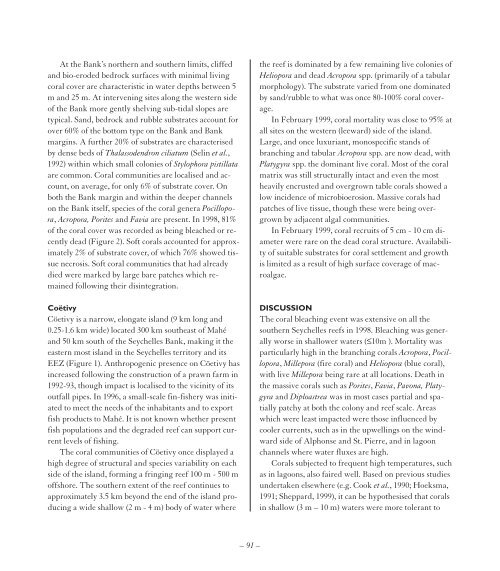Create successful ePaper yourself
Turn your PDF publications into a flip-book with our unique Google optimized e-Paper software.
At the Bank’s northern and southern limits, cliffed<br />
and bio-eroded bedrock surfaces with minimal living<br />
coral cover are characteristic in water depths between 5<br />
m and 25 m. At intervening sites along the western side<br />
of the Bank more gently shelving sub-tidal slopes are<br />
typical. Sand, bedrock and rubble substrates account for<br />
over 60% of the bottom type on the Bank and Bank<br />
margins. A further 20% of substrates are characterised<br />
by dense beds of Thalassodendron ciliatum (Selin et al.,<br />
1992) within which small colonies of Stylophora pistillata<br />
are common. Coral communities are localised and account,<br />
on average, for only 6% of substrate cover. On<br />
both the Bank margin and within the deeper channels<br />
on the Bank itself, species of the coral genera Pocillopora,<br />
Acropora, Porites and Favia are present. In 1998, 81%<br />
of the coral cover was recorded as being bleached or recently<br />
dead (Figure 2). Soft corals accounted for approximately<br />
2% of substrate cover, of which 76% showed tissue<br />
necrosis. Soft coral communities that had already<br />
died were marked by large bare patches which remained<br />
following their disintegration.<br />
Coëtivy<br />
Cöetivy is a narrow, elongate island (9 km long and<br />
0.25-1.6 km wide) located 300 km southeast of Mahé<br />
and 50 km south of the Seychelles Bank, making it the<br />
eastern most island in the Seychelles territory and its<br />
EEZ (Figure 1). Anthropogenic presence on Cöetivy has<br />
increased following the construction of a prawn farm in<br />
1992-93, though impact is localised to the vicinity of its<br />
outfall pipes. In 1996, a small-scale fin-fishery was initiated<br />
to meet the needs of the inhabitants and to export<br />
fish products to Mahé. It is not known whether present<br />
fish populations and the degraded reef can support current<br />
levels of fishing.<br />
The coral communities of Cöetivy once displayed a<br />
high degree of structural and species variability on each<br />
side of the island, forming a fringing reef 100 m - 500 m<br />
offshore. The southern extent of the reef continues to<br />
approximately 3.5 km beyond the end of the island producing<br />
a wide shallow (2 m - 4 m) body of water where<br />
the reef is dominated by a few remaining live colonies of<br />
Heliopora and dead Acropora spp. (primarily of a tabular<br />
morphology). The substrate varied from one dominated<br />
by sand/rubble to what was once 80-100% coral coverage.<br />
In February 1999, coral mortality was close to 95% at<br />
all sites on the western (leeward) side of the island.<br />
Large, and once luxuriant, monospecific stands of<br />
branching and tabular Acropora spp. are now dead, with<br />
Platygyra spp. the dominant live coral. Most of the coral<br />
matrix was still structurally intact and even the most<br />
heavily encrusted and overgrown table corals showed a<br />
low incidence of microbioerosion. Massive corals had<br />
patches of live tissue, though these were being overgrown<br />
by adjacent algal communities.<br />
In February 1999, coral recruits of 5 cm - 10 cm diameter<br />
were rare on the dead coral structure. Availability<br />
of suitable substrates for coral settlement and growth<br />
is limited as a result of high surface coverage of macroalgae.<br />
DISCUSSION<br />
The coral bleaching event was extensive on all the<br />
southern Seychelles reefs in 1998. Bleaching was generally<br />
worse in shallower waters (≤10m ). Mortality was<br />
particularly high in the branching corals Acropora, Pocillopora,<br />
Millepora (fire coral) and Heliopora (blue coral),<br />
with live Millepora being rare at all locations. Death in<br />
the massive corals such as Porites, Favia, Pavona, Platygyra<br />
and Diploastrea was in most cases partial and spatially<br />
patchy at both the colony and reef scale. Areas<br />
which were least impacted were those influenced by<br />
cooler currents, such as in the upwellings on the windward<br />
side of Alphonse and St. Pierre, and in lagoon<br />
channels where water fluxes are high.<br />
Corals subjected to frequent high temperatures, such<br />
as in lagoons, also faired well. Based on previous studies<br />
undertaken elsewhere (e.g. Cook et al., 1990; Hoeksma,<br />
1991; Sheppard, 1999), it can be hypothesised that corals<br />
in shallow (3 m – 10 m) waters were more tolerant to<br />
– 91 –


















